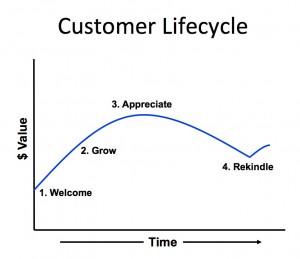How to Select Relevant Values for Your Organization
In the previous article, I outlined the process for picking unique values for your organization. These values describe your business in a way that competitors can’t say or do the same.
 Now we’ll look at how to select relevant values. These are values that make a difference in a meaningful way for all your stakeholders: customers, employees, owners, and significant others. But the primary group for consideration here are your key customers – presumably the reason you are in business.
Now we’ll look at how to select relevant values. These are values that make a difference in a meaningful way for all your stakeholders: customers, employees, owners, and significant others. But the primary group for consideration here are your key customers – presumably the reason you are in business.
Strangely, my experience has been that customer consideration occurs in fewer decisions than you might expect. This happens for many reasons, such as politics, ego, personal agendas, ignorance, and groupthink, to name a few.
One personal example. Working as a consultant for a very large company, I asked a marketing director how much time she spent “managing up.” She shocked me with her answer of 85%! So then I asked, with so much time focused internally, who is focused on understanding the needs of your customers? Her reply: “That’s why you are here!” Not good…
Sadly, this is more common than you might think. But it doesn’t have to be this way.
Lots of research has shown that the best CEOs spend a significant amount of their time visiting with key customers. For effective leaders the reasons are obvious. They need to continually:
- have a solid grip on what is important to their customers
- obtain feedback on what their organization does well, and not so well
- identify issues early, before they become major problems
- be looking for trends and new opportunities
- understand competitive threats
But I believe it should not stop with the CEO. It needs to be every leader, at every level of the organization. Whatever your role, it’s imperative to invest time in understanding your key customers.
So WHO exactly are your key customers?
3 Customer Models
 Here are three ways to identify your key customers.
Here are three ways to identify your key customers.
- Customer Lifecycle. As I wrote in a previous article, the Customer Lifecycle is a great way to pick differentiating values. In this case, there are four different customer groups based on the current business relationship. These groups are: Welcome, Grow, Appreciate, and Rekindle (appropriately labeled to describe each marketing action required). In this model, the customer group that matters most are those at the “Appreciate” stage, as they represent (currently) your best customers.
- Personas. Over the past fifteen to twenty years, there’s been a steady increase in looking at customers through the formation of customer personas. These are fictitious characters (or persons) that represent specific customer groups, generally between four to seven different types. A full persona includes a detailed bio, complete with photo, on each fictitious customer type. The point here is to evaluate which persona(s) matter most so you can make relevant and meaningful decisions that address their needs and concerns.
- Segmentation. Even the traditional way to think about customer types still works, known as the segmentation model. For B2C businesses, this includes creating customer groups based on age, income, occupation, interests, previous purchases, etc. For B2B businesses, customer groups are often formed based on company size, revenue, # of locations, buyer types, etc. The point is to think about your customers in the groups defined by your marketing and/or sales teams, and that identify the high-value ones.
Regardless of which model you use to identify your key customers, the objective is to understand the needs and concerns of your best customers, the ones that matter most to the business. Once you know the WHO, then you can assess which values are most relevant to them.
How? By simply asking them.
Selecting Relevant Values
 First, identify 8 to 12 key customers to interview. If you’re just starting up, then identify those who you consider would be ideal customers.
First, identify 8 to 12 key customers to interview. If you’re just starting up, then identify those who you consider would be ideal customers.
Rarely can customers pick the most relevant values without some kind of context. So I suggest the following process to focus your discussion.
- Share your list. Start by showing your short list of unique values, those you feel describe your organization in a way competitors can’t say or do the same. Ask them to select up to 12 values that are most relevant to them, specifically as they expect from your company. Sometimes customers can easily identify a handful of values that really resonate with them.
- Define your brand. Next, ask them to select two or three values from your list that they feel best defines their perception of your company (e.g. your brand). Then ask them WHY they selected those values (note: asking why is the most important part).
- Compare to competitors. Finally, ask them to describe two of your main competitors with one word, or sentence. Then ask them to explain why they chose that word or sentence.
Note, in these discussions with your customers it’s best to avoid questions that lead to Yes/No answers. Rather, ask questions that open the door for additional information. You’re gathering insight on what’s relevant, not making any conclusions.
In summary, the objective here is to identify a subset of your unique values that are relevant to your key customers. While this might appear a bit complex, it’s actually quite a straightforward process – and it gets easier with practice.
If you would like to explore this topic further or need help conducting customer interviews, please contact me at Robert@FergusonValues.com
For a more detailed assessment on selecting relevant values for your organization, download my free ebook Developing Your Differentiating Values for Business.








